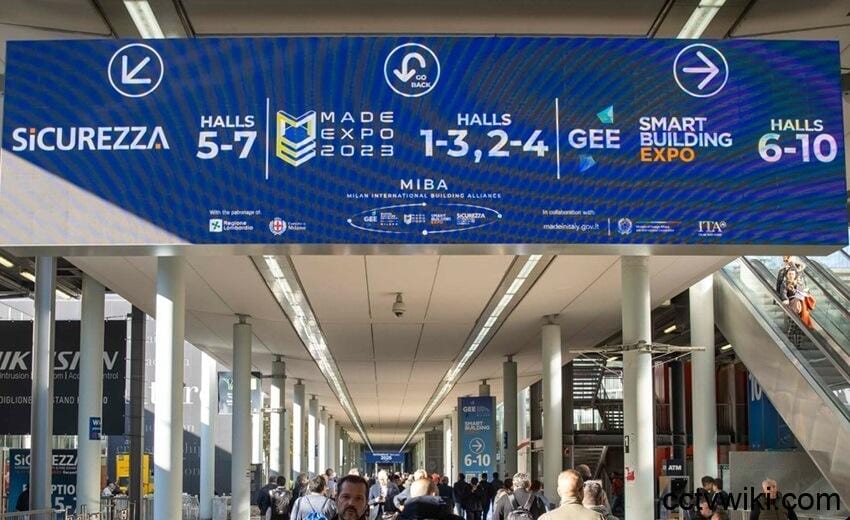The drive to create greener, more energy-efficient buildings that enhance our quality of life is now a central pillar of European policy. The upcoming implementation of the EPBD IV Directive (Energy Performance of Buildings Directive IV), coupled with the Renovation Wave – the EU’s ambitious strategy to revitalize buildings and boost energy efficiency – is poised to fundamentally reshape the construction sector.
The next few years will be critical for revitalizing and modernizing building stock, not only in Italy but across the entire European continent.
It’s against this backdrop that Fiera Milano is gearing up for the 2025 edition of MIBA – Milan International Building Alliance. Starting November 19th, this dynamic event will once again unite four leading trade shows, offering a comprehensive view of the materials, technologies, solutions, and systems that are driving the evolution of buildings and cities. GEE – Global Elevator Exhibition (focused on vertical and horizontal mobility), MADE expo (construction and architecture), SMART BUILDING EXPO (technological integration), and SICUREZZA (security & fire) will collectively host over 1,250 companies from 38 countries across eight exhibition halls. With a significant international presence, representing 28% of all exhibitors, the event draws major players from key European manufacturing hubs like Germany, Spain, Poland, and France, as well as global participants from countries like China, underscoring its worldwide reach.
A major emphasis will be placed on education and professional growth, with over 100 sessions tackling the shared challenges facing these four interconnected markets: sustainability, digitalization, security, and the integration of artificial intelligence.
“MIBA is the culmination of a strategic journey to unite previously separate markets and exhibitions, creating a powerful ecosystem that transforms technological innovation and expert knowledge into tangible business opportunities,” explains Paola Sarco, CEO of Made Eventi and Head of Building & Industry Exhibitions at Fiera Milano. “With over 1,250 increasingly international and representative companies, MIBA offers a unique platform where data, projects, and ideas are translated into real-world solutions for sustainable building and urban regeneration. Now more than ever, integration is the key to tackling the challenge of sustainability and leading the evolution of our living spaces.”
The MIBA Observatory: Unlocking the Potential of the New European Bauhaus
Developed in collaboration with MIBA’s scientific partner, the Politecnico di Milano, the Third MIBA Observatory offers a mid-term analysis (2025–2027) of the construction sector’s outlook. The report highlights the New European Bauhaus (NEB) – the European Commission’s initiative to forge a stronger connection between society, culture, and the built environment – as a significant driver of development. The NEB focuses on creating buildings that embody sustainability, beauty, and inclusivity.
The study reveals that the NEB Facility will be the primary financial instrument for implementing the NEB during 2025–2027. This European funding mechanism will mobilize over €240 million annually (50% for innovation and research, 50% for project implementation), with the goal of fostering the development and adoption of innovative solutions for transforming urban neighborhoods.
As a strategic catalyst for growth, the NEB demonstrates a powerful multiplier effect. According to sector estimates, every euro invested by the NEB Facility generates roughly 30 times its initial value in economic impact. This is due to the activation of national co-funding, regional resources, private capital, real estate funds, green financial instruments, and public-private partnerships. As a result, the NEB Facility is projected to generate approximately €7 billion per year in NEB-oriented projects, totaling over €20 billion between 2025 and 2027.
For Italy alone, this translates to approximately €2.5 billion in NEB-oriented investments over the three-year period.
These resources could serve as a potent engine for innovation in the national market, encouraging projects inspired by the core principles of the New European Bauhaus – sustainability, beauty, and inclusiveness – in public, educational, residential, and cultural buildings.
NEB-oriented investments are also expected to generate significant spillover effects across all four MIBA sectors.
In construction, the domain of MADE expo, sustainable architecture will be the primary driver, representing an average of 25% of total NEB investments. Assuming an annual total investment of €7 billion, the European market for sustainable architecture components can be estimated at €5.25 billion between 2025 and 2027, with €680 million earmarked for Italy.
Another key area will be the digitalization of the built environment, including the integration of digital technologies, smart building solutions, and data management tools – central themes of SBE–Smart Building Expo. Assuming that 12% of total NEB project value is allocated to this segment, the additional European market is estimated at €2.7 billion over 2025–2027, with €350 million projected for Italy.
Within NEB projects, inclusion and accessibility are fundamental values, and vertical mobility solutions – represented by GEE-Global Elevator Exhibition – are often integral to project design. Assuming an average of 2.5% of NEB project value is devoted to internal mobility, this would amount to €500 million over the period, with €65 million estimated for Italy.
Finally, the security sector, at the heart of SICUREZZA, represents a cross-cutting component of NEB projects. The push toward intelligent and sustainable buildings calls for advanced security integration – such as IoT-based early fire detection systems, smart compartmentalization, environmental sensors, passive surveillance, and CPTED (Crime Prevention Through Environmental Design) technologies. With an estimated 5.5% share of total NEB funding, the European annual market for building security would reach €1.2 billion between 2025 and 2027, with €150 million expected for Italy.
The 4 Pillars of MIBA
GEE – Global Elevator Exhibition (November 19–21, 2025, Fiera Milano)
GEE, the international hub for vertical and horizontal mobility, will host over 100 companies, 20% of which are from abroad. It will showcase technological innovation, safety, sustainability, and predictive maintenance, with a strong focus on professional training through certified sessions, industry talks, and B2B meetings.
MADE expo (November 19–22, 2025, Fiera Milano)
Italy’s leading event for construction and architecture, MADE expo will feature over 650 companies from 29 countries. Key themes will include building safety, sustainability, and innovation, with a focus on high-performance materials, artificial intelligence, and new design technologies. The event will also host the MADE Sustainability Prize, the return of FEL – Festival dell’Edilizia Leggera, and the Inspirational Talk “AI Architectural Intelligence,” dedicated to exploring AI’s role in reshaping future spaces.
SBE–Smart Building Expo (November 19–21, 2025, Fiera Milano)
SBE confirms its position as the international platform for technological integration in buildings and cities. With over 140 exhibitors from 17 countries and a rich program of workshops, talks, and innovation areas, the event will explore the opportunities and challenges of the built environment’s twin transition through three thematic days on decarbonization, electrification, smart buildings and smart cities. A dedicated renewable energy area and a focus on lighting technology will round out the offering on energy efficiency.
SICUREZZA (November 19–21, 2025, Fiera Milano)
SICUREZZA 2025 confirms its role as a European benchmark for security & fire, featuring 340 exhibitors from 26 countries. With a comprehensive showcase covering all segments of the sector, it will highlight a rapidly evolving market increasingly focused on complex, integrated, and interconnected solutions. New for this edition is a three-day training program — Cyber Day, Security Day, and Job in Security Day — dedicated to the industry’s major challenges: data protection in an increasingly digital world, solution customization, talent recruitment, and skill development.

